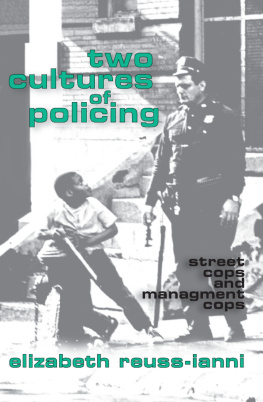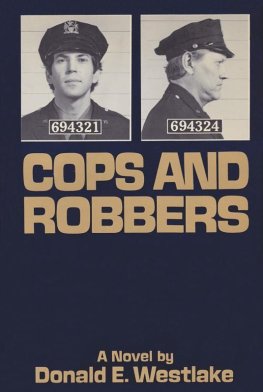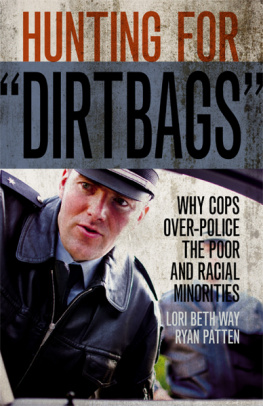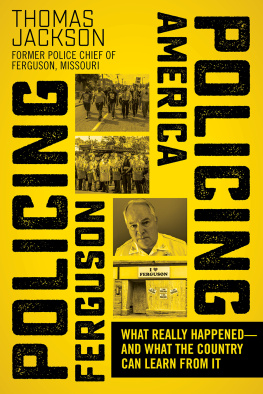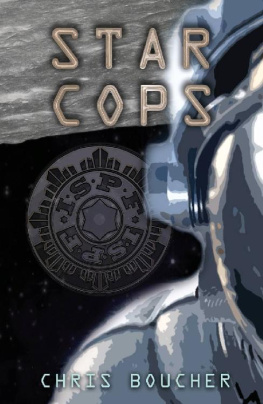First published 1983 by Transaction Publishers
Published 2017 by Routledge
2 Park Square, Milton Park, Abingdon, Oxon OX14 4RN
711 Third Avenue, New York, NY 10017, USA
Routledge is an imprint of the Taylor & Francis Group, an informa business
Copyright 1983 by Taylor & Francis.
All rights reserved. No part of this book may be reprinted or reproduced or utilised in any form or by any electronic, mechanical, or other means, now known or hereafter invented, including photocopying and recording, or in any information storage or retrieval system, without permission in writing from the publishers.
Notice:
Product or corporate names may be trademarks or registered trademarks, and are used only for identification and explanation without intent to infringe.
Library of Congress Catalog Number: 2016026856
Library of Congress Cataloging-in-Publication Data
Reuss-Ianni, Elizabeth, 1944-
Two cultures of policing.
Bibliography: p.
Includes index.
1. New York (N.Y.) Police. 2. Police administration New York (N.Y.) 3. Police patrol New York (N.Y.) I. Title.
HV8148.N5R48 352.209747 1
ISBN 1-56000-654-4
82-7079
AACR2
ISBN 13: 978-1-56000-654-1 (pbk)
ISBN 13: 978-0-87855-469-0 (hbk)
Throughout the eighteen months in which I carried out this research, I worked with, socialized with, observed, and interviewed many police officers in the New York City Police Department. I spent a great deal more time with some than with others, but found everyone very cooperative and courteous. To single out particular officers for special acknowledgment might place more responsibility on them for some of the more critical comments than they deserve. They know who they are and I hope that they know that they have my appreciation and respect.
Professor Howard S. Becker of Northwestern University was a constant consultant and advisor throughout the project and was particularly helpful in analyzing the data and organizing the final manuscript. Mr. Peter Gibbon deserves a special note of appreciation in the preparation of the sections on related police literature.
Without the financial support of the National Institute of Law Enforcement and Criminal Justice, this research could not have been undertaken. I would like to particularly thank the project monitor, Kay Monte-White, and David Farmer, former director of police programs for the National Institute of Law Enforcement and Criminal Justice, for their constant interest and support. Of course, points of view or opinions stated here are those of the author and do not represent the official position or policies of the United States Department of Justice.
As always, I worked closely with my husband and colleague Fritz Ianni and again, as always, it is impossible to know where his ideas and feelings and mine begin and end.
THE POLICE COMMISSIONER ISSUED THE FOLLOWING DIRECTIVE TO THE CHIEF OF OPERATIONS:
Tomorrow evening at approximately 2000 hours, Haleys Comet will be visible in this area, an event which occurs only once every 75 years. Have the men assemble in front of the station house in uniform and I will explain this rare phenomenon to them. In case of rain we will not be able to see anything, so assemble the men in the sitting room and I will show them films of it.
THE CHIEF OF OPERATIONS DIRECTED THE AREA COMMANDER:
By order of the Police Commissioner: Tomorrow at 2000 hours Haleys Comet will appear above the station house. If it rains, fall the men out in uniform and then march to the sitting room where the rare phenomenon will take place, something which occurs only once every 75 years.
THE AREA COMMANDER ORDERED THE PRECINCT COMMANDING OFFICER:
By order of the Police Commissioner in uniform at 2000 hours tomorrow evening the phenomenal Halleys Comet will appear in the sitting room. In case of rain in front of the station house, the Police Commissioner will give another order, something which occurs once every 75 years.
THE PRECINCT COMMANDING OFFICER ISSUED THE FOLLOWING ORDER TO THE ADMINISTRATIVE LIEUTENANT:
Tomorrow at 2000 hours, the Police Commissioner will appear in front of the station house with Halleys Comet, something which happens every 75 years. If it rains, the Police Commissioner will order the Comet into the sitting room.
THE ADMINISTRATIVE LIEUTENANT MADE THE FOLLOWING ANNOUNCEMENT AT ROLL CALL:
When it rains tomorrow at 2000 hours, the phenomenal 75 year old Chief Halley, accompanied by the Police Commissioner will drive his Comet through the station house in uniform.
AN HOUR LATER ONE OF THE COPS ASKED THE SERGEANT FOR CLARIFICATION OF THE LIEUTENANTS ANNOUNCEMENT AT ROLL CALL AND THE SERGEANT SAID:
Chief Halley, the new Area Commander, is going to test a new RMP here tomorrow, if it doesnt rain.
A SHORT TIME LATER, A P.A.A. ASKED THE COP IF HE KNEW WHAT WAS GOING TO HAPPEN TOMORROW, THE COP SAID:
Forget it, you civilians cant get anything straight anyway.
Anonymous Graffiti from the NYPD
Early in September of 1976, Francis Ianni and I, with financial support from the National Institute of Law Enforcement and Criminal Justice, began a long-term study of the social organization of the police precinct in New York City. What we learned through the two-year study, after hundreds of hours working, observing, and interviewing officers in two precincts, is that the organization of policing is best described and understood in terms of the interactions of two distinct cultures: a street cop culture and a management cop culture. These two cultures are increasingly characterized by competing and often conflicting perspectives on procedure and practice in policing. This situation is significant since much of the research and literature of policing describes the working of a monolithic single cop culture that pervades all levels of the organization. The emergence of two cultures has implications for the introduction of new techniques for management and operation, and for the introduction of new personnel policies and procedures, as well as for understanding the manner and method of the day-to-day practice of policing.
The pervasive conception of the good old days of policing is the organizing ethos of street cop culture, orienting individual officers and precinct social networks and defining the day-to-day job of policing. In the good old days, the public valued and respected the cop, fellow officers could be counted on and the bosses, or higher ranking officers, were an integral part of the police family. Cops not only had public respect and the sense of security which came from belonging to a cohesive, interdependent organization, but were treated as professionals who knew their job and how best to get it done. A grateful public and an understanding city hall seldom asked how. Everybody, say the cops, knew who were the good guys and who were the bad guys, and the political system and the community they represented agreed with their definitions. Being a policeman was something special; a cop put his life on the line and people appreciated and respected his willingness to do so. As a result, policemen were allowed to do their jobs without too many questions or too much interference from outside the department. Not only the street cops, but everyone in the department was socialized to this ethos. Since there is no lateral entry into the department, everyone began his career as a cop and, they believed, everyone from the chief on down accepted the values of loyalty, privilege, and the importance of keeping department business inside the department. One monolithic culture permeated the department.



